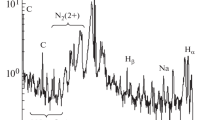Abstract
The thermal decomposition of nitric oxide (diluted in Argon) has been measured behind incident shock waves by means of IR diode laser absorption spectroscopy. In two independent runs the diode laser was tuned to theν=0 →ν=12 Π 3/2 R(18.5)-rotational vibrational transition and theν=1 →ν=22 Π 3/2 R(20.5)-rotational vibrational transition of nitric oxide, respectively. These two transitions originating from the vibrational ground state (ν=0) and the first excited vibrational state (ν=1) were selected in order to probe the homogeneity along the absorption path. The measured NO decomposition could satisfactorily be described by a chemical reaction mechanism after taking into account boundary layer corrections according to the theory of Mirels. The study forms a further proof of Mirels' theory including his prediction of the laminar-turbulent transition. It also shows, that the inhomogeneities from the boundary layer do not affect the IR linear absorption markedly.
Similar content being viewed by others
References
Fujii N, Koshi M, Ando H, Asaba T (1979) Evaluation of boundary-layer effects in shock-tube studies of chemical kinetics. Int J Chem Kinetics 11:285
Goldman A, Schmidt SC (1975) Infrared spectral line parameters and absorptance calculations of NO at atmospheric and elevated temperatures for theΔν=1 bands region. J Quant Spectrosc Radiat Transfer 15:127
Mirels H (1963) Test time in low-pressure shock tubes. Phys Fluids 6:1201
Mirels H (1964) Shock tube test time limitation due to turbulent-wall boundary layer. AIAA J 2:84
Mirels H (1966) Flow nonuniformity in shock tubes operating at maximum test times. Phys Fluids 9:1907
Mirels H (1971) Boundary layer growth effects in shock tubes. In: Stollery JL, Gaydon AG and Owen PR (eds) Proc 8th Int Shock Tube Symp, London
Moser LK, Hindelang FJ (1989) Vibrational relaxation of NO behind shock waves. Exp Fluids 7:67
Moser LK, Hindelang FJ (1989) Shock-tube study of the vibrational relaxation of nitric oxide. In: Kim WY (ed) Proc 17th Int Symp Shock Waves and Shock Tubes, Bethlehem PA, USA
Thielen K, Roth P (1984) Resonance absorption measurements of N and O atoms in high temperature NO dissociation and formation kinetics. In: Proc 20th Int Symp Combustion
Author information
Authors and Affiliations
Additional information
This article was processed using Springer-Verlag TEX Shock Waves macro package 1.0 and the AMS fonts, developed by the American Mathematical Society.
Rights and permissions
About this article
Cite this article
Moser, L.K., Hindelang, F.J. Boundary layer effect on thermal NO decomposition behind incident shock waves. Shock Waves 2, 129–132 (1992). https://doi.org/10.1007/BF01414634
Received:
Accepted:
Issue Date:
DOI: https://doi.org/10.1007/BF01414634




